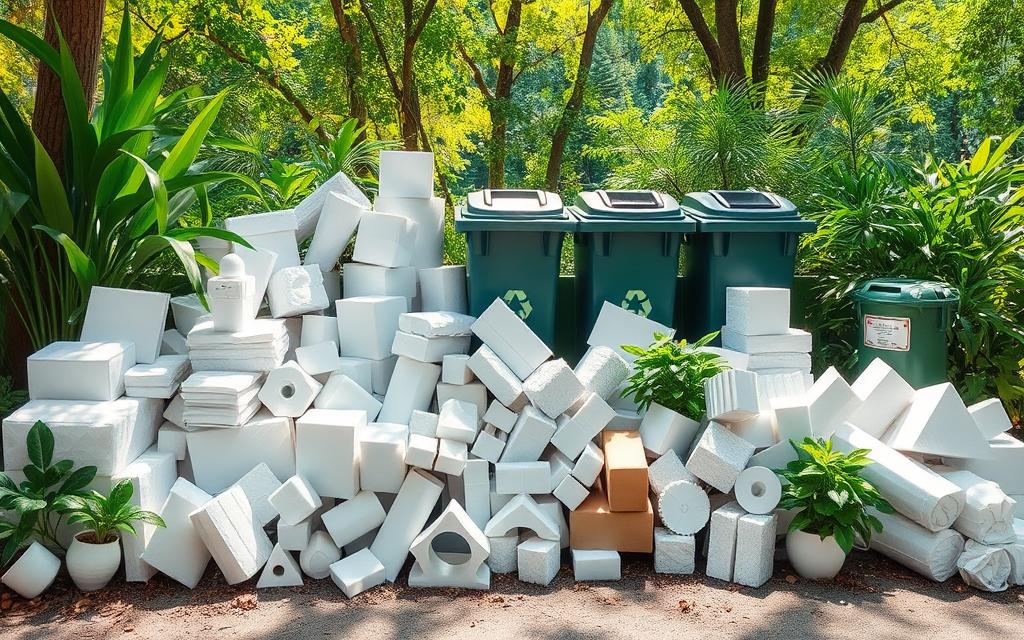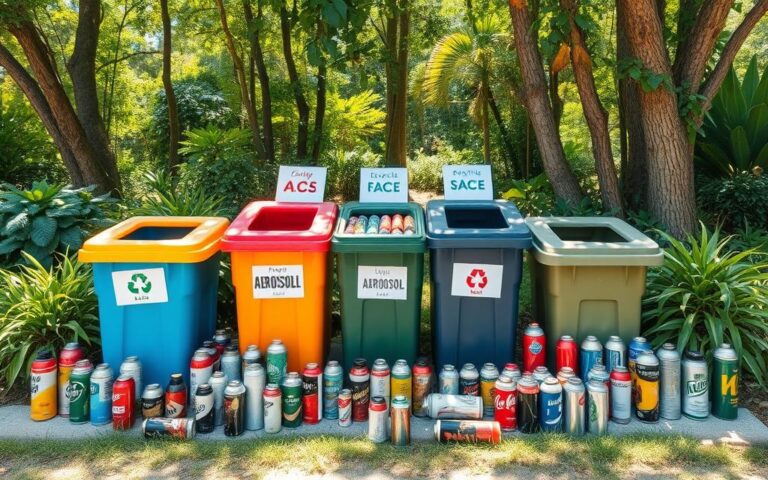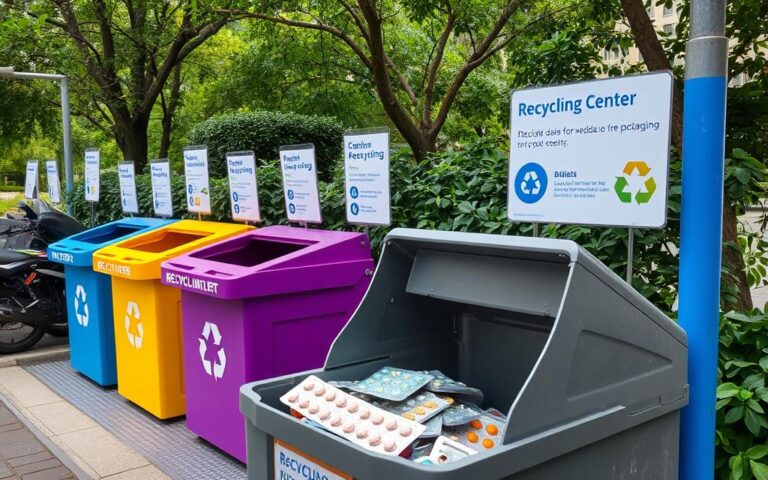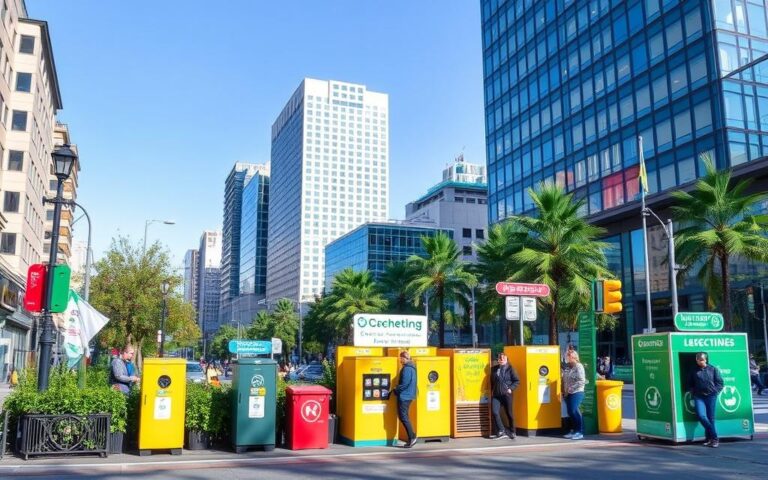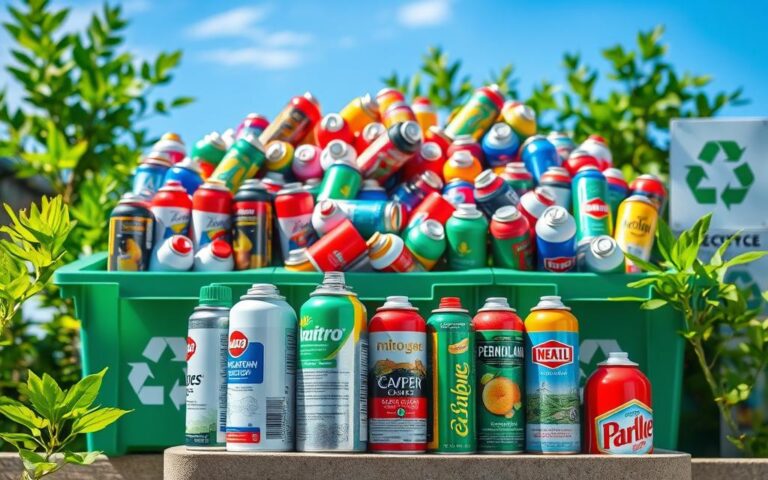Do You Recycle Styrofoam? Responsible Disposal Options
Styrofoam, also known as expanded polystyrene (EPS), is popular for packaging and food containers. It’s lightweight and has good insulating properties. Yet, it harms the environment, as it’s hard to recycle and often ends up in landfills. Even though many think it can be recycled, most curbside recycling programmes won’t take it. This article looks at ways to dispose of styrofoam responsibly, including new methods and alternatives, to lessen its environmental impact.
Key Takeaways
- Styrofoam is mostly air, which makes its recycling hard and not very effective.
- Some recycling programmes are now dealing with styrofoam waste, but it’s still a big challenge.
- Turning styrofoam into things like picture frames and park benches is a clever waste solution.
- The lack of recycling options for people adds to the problem EPS causes for the environment.
- There are new recycling methods being looked into, including chemical techniques, as possible ways to tackle this issue.
Understanding Styrofoam and Its Environmental Impact
It’s important to know what styrofoam is when looking at its environmental effects. Styrofoam, also called expanded polystyrene (EPS), is often used for packaging, insulation, and food containers. It is made of about 98% air and 2% polystyrene. This makes it very light but still has a big impact on waste management.
What is Styrofoam?
Styrofoam is made from polystyrene and is known for being strong and good at insulating. It is used in many ways, like in food packaging and building materials. But, it doesn’t break down in nature, causing big environmental problems. It can stay in the environment for more than 500 years, adding to land and sea pollution.
The Longevity of Styrofoam in The Environment
Styrofoam’s light and low-density nature means it fills up landfills fast. In many places, there’s no good way to recycle it. In the U.S., only 1% to 2% of it is recycled each year. This leaves a lot of styrofoam to just sit in landfills, showing we need better waste solutions. Also, food residue makes recycling even harder.
The Environmental Challenges Posed by Styrofoam
The impact of styrofoam on the environment is huge. Not only does it last a long time in landfills, but making it also uses a lot of energy and releases harmful gases. There are ways to recycle styrofoam, turning it into things like picture frames. Companies and waste management need to work together to recycle more styrofoam. It’s also essential for everyone to know how to properly handle styrofoam waste.
Want to learn more about styrofoam recycling and its challenges? Check out this helpful resource.
Do You Recycle Styrofoam? Exploring the Possibilities
Recycling styrofoam, especially expanded polystyrene (EPS), is tough. Most local recycling programs won’t take it, even though it seems like they could. This is because it’s light, but bulky, making it hard to process without contamination. It’s important to know your city’s recycling options to deal with this pollutant properly.
The Curbside Recycling Dilemma
Curbside recycling services around the world usually don’t accept EPS. It’s hard to clean and it takes up too much space. Currently, only about 12 per cent of polystyrene gets recycled. The rest might end up in landfills, which harms the environment because they take a long time to break down. We need better ways to dispose of EPS.
City-Specific Recycling Options
Some cities, like Los Angeles, try to recycle styrofoam with special programs, but these are rare. It’s essential to check local rules and what’s actually recycled. There may be places to drop off EPS for recycling, but they have rules about what they can take. This makes recycling styrofoam hard.
| City | Curbside EPS Acceptance | Special Recycling Programme |
|---|---|---|
| Los Angeles | No | Drop-off sites available |
| New York | No | Some schools and businesses participate |
| Chicago | No | Limited EPS recycling centres |
Knowing the limits and options for recycling in your city helps. It means you can help make your community cleaner and more environmentally friendly.
Methods for Responsible Styrofoam Disposal
It’s vital we dispose of styrofoam in an eco-friendly way. Many ways are there to prevent it from harming our planet. Finding the right disposal methods can greatly help.
Local Recycling Centres
Some local recycling spots take clean styrofoam. They have the setup to process expanded polystyrene (EPS) properly. Always check if they take styrofoam before you go, as it differs by area.
Mail-in Recycling Programs
If you can’t find a recycling centre nearby, try mail-in programs. You can send clean styrofoam to firms that recycle it. This might cost you, but it’s good for when you’re stuck.
Utilising Packing Stores for Packing Peanuts
For packing peanuts, use local packing stores. Shops like UPS will reuse them, which is good for the earth. Just make sure they’re dry and clean before you drop them off.
Reducing Styrofoam Usage: Practical Tips
We all have the power to reduce styrofoam usage by choosing wisely. By picking different materials, we help the planet. This means everyone needs to work together for a sustainable future.
Opting for Alternatives to Styrofoam
It’s vital to find alternatives to styrofoam. Luckily, there are many:
- Cornstarch containers are good for the earth and food.
- Recycled paper works well for lighter items.
- Products shipped in natural fibre materials, not foam.
Every choice we make helps our environment. More companies are now choosing sustainable packaging solutions. By supporting these options, we encourage even more positive change.
Encouraging Businesses to Reduce Styrofoam Packaging
Pushing companies to reduce styrofoam packaging can lead to big changes. When shoppers ask for green products, businesses and makers listen. Here’s how to help:
- Buy from eco-friendly shops.
- Ask for products in green packaging.
- Use social media to praise good practices.
Steps like these can really make a difference in packaging choices. Want to know more about eco-friendly options? Check out this guide on Styrofoam disposal.

The Importance of Proper Styrofoam Disposal
Managing styrofoam waste carefully shows we care for our planet. Knowing how to dispose of it properly reduces harm. Everyone has a role in fighting styrofoam pollution.
The Consequences of Improper Disposal
Throwing styrofoam away the wrong way pollutes our environment and harms animals. Not many local places recycle styrofoam, making it hard for people to get rid of it right. This often leads to too much styrofoam ending up in landfills.
Even though styrofoam is light, it takes up a lot of room. This makes landfills fill up faster, which is a big problem.
Why Landfills May Be a Last Resort
Sometimes, we have no choice but to put styrofoam in landfills. Not many recycling places can handle it properly because they need special gear. Often, it’s too expensive to send it to places that can recycle it.
Learning about where we can take styrofoam for recycling is important. The Foodservice Packaging Institute and the Plastic Loose Fill Council have info on this. They tell us how we can recycle or reuse styrofoam.
Conclusion
The challenge of recycling styrofoam is a big environmental issue we all need to tackle. In 2018, the US made a whopping 550,000 tons of styrofoam products. Sadly, less than 4% of this was recycled. We need to focus on better ways to get rid of styrofoam and find other options to lessen its damage to the planet.
Even though recycling styrofoam is hard and costly, we can still make a difference. By pushing for green habits, we help raise awareness in our communities. There are cool ideas out there like sending styrofoam back through mail programs or taking it to local places that can handle it. Every smart choice helps our Earth.
Styrofoam takes up to 500 years to break down, which is a big problem for the future. It can harm our soil and water with tiny plastic particles. If we choose different materials and better ways to throw things away, we’ll rely less on stuff that hurts the planet. This way, we protect our world for kids and grandkids down the line.
FAQ
Is styrofoam recyclable?
Most places won’t pick up styrofoam in curbside recycling, making it hard to recycle. Yet, some recycling centres might take it if it’s clean and hasn’t been contaminated.
What are eco-friendly alternatives to styrofoam?
Options like cornstarch containers, recycled paper, and reusable items are good. They’re getting more used as shops look for greener ways to package.
How long does styrofoam persist in the environment?
Styrofoam can linger for up to 500 years, harming lands and seas. This poses serious risks to our environment.
What should I do with unwanted styrofoam?
Look for a recycling centre that takes styrofoam. You can also use mail-in programmes. Or, take clean packing peanuts to places like UPS for them to use again.
Why is styrofoam considered problematic?
Even though it’s light and keeps things warm or cold, styrofoam doesn’t break down. It fills up landfills and can harm animals and plants if we don’t get rid of it right.
How can I influence businesses to reduce their use of styrofoam?
Tell companies you like sustainable packaging. Support those that are eco-friendly. Also, push for better choices in your area. This can lead to change.
What are the consequences of improper styrofoam disposal?
Throwing it away wrongly can pollute, hurt animals, and make places dirty. Make sure to dispose of styrofoam properly to protect nature.
Are there any specific guidelines for recycling styrofoam in my city?
Rules for recycling styrofoam differ everywhere. Always check with your local recycling service to know how to properly handle styrofoam.

